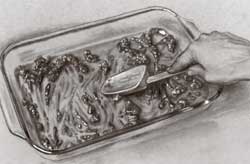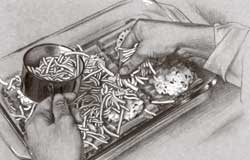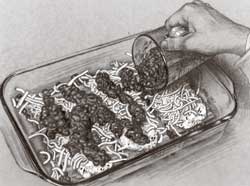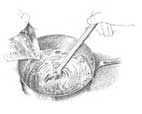Serves 8 to 10.
INGREDIENTS
1 tablespoon canola or olive oil
8
ounces white mushrooms, sliced thinly
2
celery ribs, chopped fine
1
onion, chopped fine
1
red bell pepper, stemmed, seeded, and chopped fine
1 1/2
pounds hamburger (85% lean)
salt and pepper
2 tablespoons minced fresh oregano
1 can (28 ounces) tomato puree (I like Cento brand)
1 can (14-ounce) can diced tomatoes (Cento brand)
2 cups ricotta (whole milk)
1 ¼ cups grated Parmesan cheese
1/2
cup chopped fresh basil
1
large egg, lightly beaten
1/2
teaspoon pepper
salt
16 no-boil lasagna noodle (I like Trader Joe's or Barilla brand)
4 cups whole milk or part-skim mozzarella, shredded
INSTRUCTIONS
1. Adjust oven rack to middle position and heat oven to 375 degrees.
2. Heat oil in large, heavy-bottomed Dutch oven over medium heat until shimmering but not smoking, about 2 minutes; add onion, mushrooms, celery, bell pepper, and 1 teaspoon salt and cook, stirring occasionally, until softened but not browned, about 6-8 minutes. Add garlic, oregano, and 1/2 teaspoon pepper, and cook until fragrant, about 30 seconds. Increase heat to medium-high and add beef, salt, breaking up into small pieces with wooden spoon, until no longer pink but not browned, about 5 minutes. Stir in pureed and diced tomatoes with liquid, and bring to simmer; reduce heat to low and simmer slowly until flavors are blended, about 3 minutes; set sauce aside. Taste for salt and pepper.
3. Mix ricotta, 1 cup Parmesan, basil, egg, 1/2 teaspoon salt, and pepper in medium bowl with fork until well-combined and creamy; set aside.
4. Assemble first lasagna layer according to illustrations below. Repeat layering of noodles, ricotta, mozzarella, and sauce two more times. Place 4 remaining noodles on top of sauce, spread remaining sauce over noodles, sprinkle with remaining cup mozzarella, then with remaining 1/4 cup Parmesan. Lightly spray a large sheet of foil with nonstick cooking spray and cover lasagna. Place pan on foil-lined lipped baking sheet. Bake 15 minutes, then remove foil. Return lasagna to oven and continue to bake until cheese is spotty brown and sauce is bubbling, about 35 minutes longer. Cool lasagna about 20 minutes; cut into pieces and serve.
If cooked the day before: Bake 30-40 minutes, then remove foil. Return lasagna to oven and continue to bake until cheese is spotty brown and sauce is bubbling, about 35 minutes longer. Cool lasagna about 20 minutes; cut into pieces and serve.
.
STEP-BY-STEP
Assembling Lasagna
1. Smear entire bottom of 9 by 13 inch baking dish with 1 cup meat sauce. Place 4 noodles on top of sauce. (I think this size is too small; I would use 10 by 15 inch baking dish next time; you might need more noodles if you choose larger pan.)
2. Drop 3 tablespoons ricotta mixture down center of each noodle. Level by pressing flat with back of measuring spoon.
3. Sprinkle evenly with 1 cup shredded mozzarella.
4. Spoon 2 1/2 cups meat sauce evenly over cheese.
STEP-BY-STEP




Assembling Lasagna

1. Smear entire bottom of 9- by 13-inch baking dish with 1 cup meat sauce. Place 4 noodles on top of sauce.

2. Drop 3 tablespoons ricotta mixture down center of each noodle. Level by pressing flat with back of measuring spoon.

3. Sprinkle evenly with 1 cup shredded mozzarella.

4. Spoon 1 1/2 cups meat sauce evenly over cheese.




